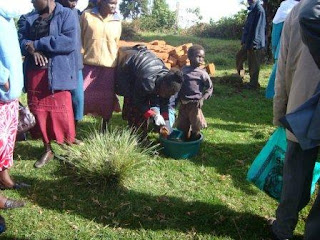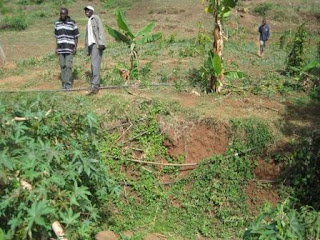Head Teacher Mr. Chumba and Founder Chris Cheboiboch. Chris, who twice placed second in Boston and New York Marathons, used his running earnings to found the school.
Uhuru and Apollo attended Salaba Academy, a private school that includes preschool to Standard 8 (equal to 8th grade). I visited several times and had many discussions with people about education in Kenya. Here are some of my impressions:
1) The teachers’ role is different than in the United States. The teachers would present a concept and assign work. Then the teachers would go to the staff room, which is somewhat of a misnomer. In the US the staff room is a teachers lounge. In Kenya the staff room is a shared office.
2) Discipline is very strict. Students are expected to work, and if they do not, they get caned. Students stand up when a teacher or adult enters the classroom. The following dialogue occurs:
Teacher: “Good morning class. How are you?”
Class: “Good morning, sir. We are fine, thank you.”
Teacher: “You may sit down.”
Class: “Thank you, sir”
There is absolutely NO talking when a teacher is talking. One morning I saw all 300 students at Salaba at an outdoor assembly. There was no talking at all. The head teacher spoke quietly to the students. There was no background noise.
Salaba student body at the assembly
3) There is corporal punishment in school. One day Uhuru came home with a science practice test. She had scored about 20%. She was determined to study because the teacher said anyone who scored less than 80% on the final test would be caned. (She scraped through with an 80%.)
4) Information like test scores that would be private in the US are public in Kenya. In fact, the semester final exam scores of every student in the school are posted outside the head teacher’s office for all visitors to see.
5) There is a lot of rote memorization. Students copy passages and information from the teacher and then put the information on their tests. In math students in the United States draw pictures and use models to understand how to multiply fractions and why the method works. In Kenya, students are taught: “multiply the top and bottom.”
Mercy and Hilda, two of Uhuru's classmates, studying.
6) Kenyan students are very dedicated. On my morning runs I would see Kenyan students walking to school at 6AM. The distance they walked varied quite a bit, but many walked several miles. Boarding students at Salaba are up before 5AM. During the time between terms there is a special session called “tuition.” During tuition students are in class from 6AM-9PM.
7) Students take on other responsibilities. Boarding students must wash their clothes by hand. Students living at home do chores and help care for their siblings.
8) No pampering. In the assembly, the head teacher addressed two issues: “Look at your shoes. Look at your shirts. You are dirty. You have time in the afternoon before supper. You need to wash your clothes. Wash your shoes.” “The examination results for Standard 7 are not good. You need to study more.” Messages are not sugar-coated. Grade inflation does not exist in Kenya. The 2009 secondary school graduation scores for the Keiyo district are shown below: 2568 students took the exam. 6 students earned A’s and 34 earned A-‘s. C+ is considered the pass mark to enter university.
9) There are huge variations in access to quality education in Kenya. Students who earn A’s and A-‘s on their secondary exams earn a full scholarship to university. This should allow children from all over Kenya to access higher education, but the top universities are dominated by the wealthier children from urban areas. There are huge differences in the funding and quality of schools in Kenya. The 2009 analysis above shows that not one student from the bottom two schools passed the exam.
10) There is a huge teacher shortage in Kenya. In some schools there is not always money for salaries, or the school may run out of money. I read an article in the newspaper written by a teacher. He wrote that the head teacher admonished two teachers: “You need to have your lesson plans in order.” The teachers responded “We have not been paid for three months. Once we are paid, we will put our plans in order.”
Classroom. Not many supplies!
11) Even the wealthier schools, like Salaba Academy, have little compared to American schools. Salaba actually had a computer lab with about 15 PCs. But the standard classroom had desks and a blackboard painted on the wall. That’s it. We complain about school funding in the US, but even the most run down school in the US looks like a palace compared to most schools in Kenya.



















